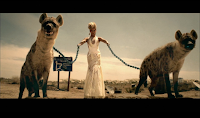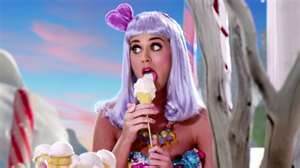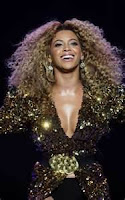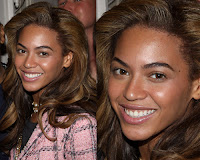Conventions of a music video
Cinematography is usually very similar in every
genre of music video although each form of video could use different shots or
angles. The three main types of camera shots that are used in every video are
close ups, medium close ups and long shots. Close ups and medium close ups are
used to see the emotion and facial expressions of the artist; the lyrics that
they are singing; makeup and hair styling that has been done and medium close
ups allow us to see a bit of what the artist is wearing which tells us a bit
more about themselves. Long shots act as establishing shots which bring context
and understanding to the video and also allow us to see a dance routine or
performance if one is featured in the video. Camera shots that are sometimes
used on a less regular basis are over the shoulder shots if they want a
conversational aspect in the video and two shots or wide shots which are
usually only used if the video is for a band or more than one person is
required in the shot. Two shots and wide shots can also be used to show dancers
or other performers besides the featured artist.
Camera movement is very important in a music video and the most common types used are pans and zooms. Pans act as another way of including more than one person in a shot, allow us to see the setting or surroundings they are in and also just give the camera movement so the shots flow into one and the transition is smoother. Zooms also allow the shots to flow. Zooming in means we can see things on the artists or specific object clearer meaning it could be used for a change in mood during the song. Zooming out allows us to see more of the person, the actions they are doing and what they are wearing. Tilts can be used in a similar way to zooming out and can establish the artist and how they dress and act. They could also be used to show positions of authority if it’s a song about gangs etc just like high and low angle shots can be. Crane shots are a common occurrence of performance videos as they are good for hovering above the stage and also including the audience in the shot: arial shots can also be used in a similar way. Steadicam is a technique that will be used in most videos as it is easier to film that way and again allows the shots to flow more freely. It can be made very obvious in some videos that steadicam is being used especially if it features some “home movie” filming.
Sound
The sound in a music video is usually very simple as it contains the lyrics of the song but some music videos have a narrative voice over at the beginning, end or both in which more information is given about the song or story within the video. Sound effects can also be a feature of a music video but these are very specific to certain genres. Volume is another area of the sound that can be manipulated in a music video as there may be dialogue over the song and therefore it is lowered. Some artists also like to feature a bit of the original recording in their video with means that sound quality is different.
Editing
 Continuity editing and montage editing
are the two main types of editing that are used in music videos. Montage
editing allows lots of different things to be going on in the video and can
allow a story to be told whereas continuity editing is better for dance routine
videos and giving an emotive performance. Continuity editing makes a very
simple video but an effective one too. Editing jump cuts into a video is a good
way of moving from one scene into another. Super imposition is something that
can be included using different extremes such as just changing a background
behind an artist after filming it in front of a green screen or using CGI to
super impose animals or even people that would not have been there during the
original filming of the video.
Continuity editing and montage editing
are the two main types of editing that are used in music videos. Montage
editing allows lots of different things to be going on in the video and can
allow a story to be told whereas continuity editing is better for dance routine
videos and giving an emotive performance. Continuity editing makes a very
simple video but an effective one too. Editing jump cuts into a video is a good
way of moving from one scene into another. Super imposition is something that
can be included using different extremes such as just changing a background
behind an artist after filming it in front of a green screen or using CGI to
super impose animals or even people that would not have been there during the
original filming of the video.
Mise-en-scene
 Mise-en-scene
is what makes the video unique and this is where the genres are definitely
identified. Costume and makeup is very important for giving the artist their
image, as a rock star would not want to be placed in a glittery dress and
bright red lip stick. The costumes are what most people in the audience are
going to relate to so the clothing and makeup artists definitely need to make
sure they get it right. The lighting is also very dependent on the type of
video that is being shot. Pop and RNB songs are usually brighter and fluffier
because the songs are usually happy and up tempo but if it is a ballad the
colour schemes and lighting are often calmer as this helps the audience know
how to feel. It also wouldn’t be right is a heavy metal band had a bright music
video when they were singing about death so it works both ways. The location of
the music video is usually determined by the genre of song. To make the video
as conventional as possible it is important to shoot the video in a suitable
place. “The Captain” by Biffy Clyro is filmed on what looks like a pirate ship
and it also contains scenes of dungeons. It is quite an aggressive video but
that matches the aggressiveness of the song. The tempo and the aggression would
not be portrayed well if the video was filmed in a dance studio because the
image would be clean cut and the song would be the complete opposite. The
lighting in the video is very dark with a lot of bright flashes which occur at
the same time as the drum beat. The singer in the band is also very “rocky”
with his tattoos all over his body, black hair and he is sweating quite a lot
which is what you assume
to happen at a rock concert.
Mise-en-scene
is what makes the video unique and this is where the genres are definitely
identified. Costume and makeup is very important for giving the artist their
image, as a rock star would not want to be placed in a glittery dress and
bright red lip stick. The costumes are what most people in the audience are
going to relate to so the clothing and makeup artists definitely need to make
sure they get it right. The lighting is also very dependent on the type of
video that is being shot. Pop and RNB songs are usually brighter and fluffier
because the songs are usually happy and up tempo but if it is a ballad the
colour schemes and lighting are often calmer as this helps the audience know
how to feel. It also wouldn’t be right is a heavy metal band had a bright music
video when they were singing about death so it works both ways. The location of
the music video is usually determined by the genre of song. To make the video
as conventional as possible it is important to shoot the video in a suitable
place. “The Captain” by Biffy Clyro is filmed on what looks like a pirate ship
and it also contains scenes of dungeons. It is quite an aggressive video but
that matches the aggressiveness of the song. The tempo and the aggression would
not be portrayed well if the video was filmed in a dance studio because the
image would be clean cut and the song would be the complete opposite. The
lighting in the video is very dark with a lot of bright flashes which occur at
the same time as the drum beat. The singer in the band is also very “rocky”
with his tattoos all over his body, black hair and he is sweating quite a lot
which is what you assume
to happen at a rock concert.
My music video conventions

 The
music video I will be shooting is a pop/RNB song and although death is involved
in the lyrics, it’s about leaving a legacy so it is quite a positive song. I
will not only be following the codes and convention rules of this genre but I
will also follow the rules of other Beyoncé videos. To do this I will use close
ups and medium close ups and because of the lyrics to this song I think they
are especially important. I would also like to use long shots when filming a
continuity sequence for the chorus and like in the video “Single Ladies” I may
use a two shot to see my actress interacting with friends and family etc. Most
of my video will incorporate montage editing and to make it look smooth I would
like to use pans and zooms. Beyoncé is not known for having a narrative
sequence at the start of her videos and although I would like to create one it
wouldn’t tie in with the expectations of one of her videos so I don’t think I
will include one of these. The main codes and conventions of a Beyoncé
The
music video I will be shooting is a pop/RNB song and although death is involved
in the lyrics, it’s about leaving a legacy so it is quite a positive song. I
will not only be following the codes and convention rules of this genre but I
will also follow the rules of other Beyoncé videos. To do this I will use close
ups and medium close ups and because of the lyrics to this song I think they
are especially important. I would also like to use long shots when filming a
continuity sequence for the chorus and like in the video “Single Ladies” I may
use a two shot to see my actress interacting with friends and family etc. Most
of my video will incorporate montage editing and to make it look smooth I would
like to use pans and zooms. Beyoncé is not known for having a narrative
sequence at the start of her videos and although I would like to create one it
wouldn’t tie in with the expectations of one of her videos so I don’t think I
will include one of these. The main codes and conventions of a Beyoncé music video is down to the mise-en-scene that is used. Beyoncé has her own image that I would like to encapsulate and keep as similar to the real thing as possible. When performing Beyoncé always looks beautiful and very dressed up whether that means she is wearing a ball gown dress for a formal occasion or something short and glittery for something informal but she always has heels on and usually her hair is down. She never seems to wear too much makeup which is important and when she is “papped” doing everyday things she looks very normal so I need to remember that too. I think it would be nice to keep the performance aspect of my music video very simple. Because of the huge star Beyoncé is, her videos are always bright and colourful. There seems to be a positive energy in all her videos through light and setting so I would like to include those too. There aren’t any specific locations she keeps going back to to do her videos so I am open to manipulate that as I wish and I think that is the case with most pop videos that they could be shot anywhere. I will include some “bling” in the video without pushing the boundaries because that is the RNB side of Beyoncé coming through and this is a very powerful ballad that I will be creating.



No comments:
Post a Comment